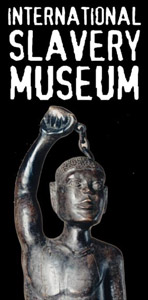
| HOME |
| NERVE |
| REVIEWS |
| ARCHIVE |
| EVENTS |
| LINKS |
| ABOUT US |
| CONTRIBUTORS |
| BACK ISSUES |
| CONTACT US |
 The
International Slavery Museum
The
International Slavery Museum
Merseyside Maritime Museum, Albert Dock, Liverpool
Opened on 23rd August 2007
Open daily 10am - 5pm, free entry
Reviewed by Alison Cornmell
In polite society it is considered rude to eavesdrop, so I felt guilty when I listened to a whole conversation at The International Slavery Museum. An elderly black gentleman passionately explained that his surname is the name given to his ancestor by a slave master. Himself and the rest of his family still don’t know anything about their true heritage, and can only trace their family tree so far. It is European polite society who is to blame for this legacy of displacement, so perhaps I shouldn’t take notice of their notions of politeness. I listened on. He proclaimed that essentially he didn’t know who he was, and neither do his family.The legacy of slavery is still prevalent today and I was never more aware of it until that moment.
The exhibition is keen to express this legacy that slavery has left. The museum-goer is led into a bright and vibrant room that has replicas of Igbo homes. This is a section that celebrates African culture. It also informs you of the European view of African culture being barbaric, so justifying the inhumane buying and selling of African men, women and children. The next room is darker and plunges you into history. It is a room filled with black and white pictures plus a model of a slave masters' home including separate quarters for his slaves. Surrounding the small model are interactive computers that narrate accounts of slaves and the sickening ways they were physically and mentally tortured.
If anyone was under the impression that this barbarity is a part of history and has no relationship with contemporary culture the museum soon proves them wrong. Racism is a direct descendent of slavery, and the narrow mindedness of our European ancestors. A silent TV screen demonstrates this with a montage of images. Black and white minstrels and gollywogs are juxtaposed with articles about the brutal slaughter of black teenager Anthony Walker, proving that racism should have no varying degrees of acceptance.
One of the quotes engraved on brick walls throughout the exhibition says, “People need to remember about slavery. It pains the ancestors when we forget.” The exhibit is comprehensive, and being held in Liverpool, is prepared to tackle the city’s prominence in the slave trade. It does not allow us to forget, and we shouldn’t. The legacy of slavery still exists many generations after abolition, so the legacy needs to be acknowledged and tackled, exactly like the exhibition does.
The Slavery Museum website: www.liverpoolmuseums.org.uk/ism